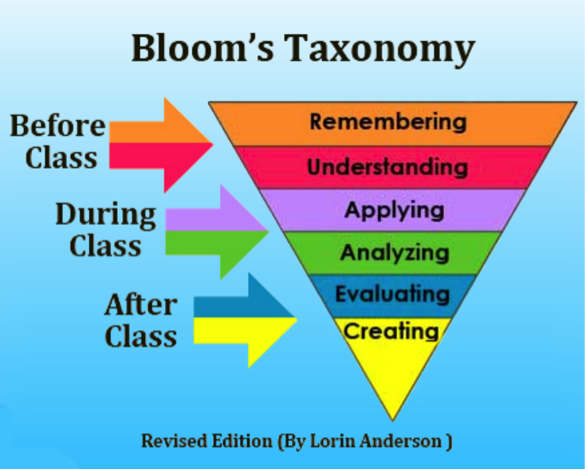Flipped classroom. Yeah, it's a thing!
Are you familiar with the term “Flipped classroom”?

Here the students learn the theory on the topic at home and work on “homework” in class. This allows the teacher to use class time more efficiently. A quest is perfect to have students discover content independently. Pick the tasks carefully to make sure students come to class the next day armed with opinions and questions, and great group discussions are sure to follow.
Fitting into the Bloom Taxonomy
In traditional learning, lower level of learning such as remembering and understanding are happening in class, while students are usually left to work on activities that involve higher level of learning outside of classroom. However, in the flipped classroom model, learning is flipped.
In traditional learning, lower level of learning such as remembering and understanding are happening in class, while students are usually left to work on activities that involve higher level of learning outside of classroom. However, in the flipped classroom model, learning is flipped.
As you can see from the pyramid, students can finish the lower level of cognitive work before class. And when they come to class, they can engage in higher cognitive levels of learning with peers and teachers present.

Don't you feel like the online learning we have been experiencing looks like it a bit? What if we could really apply it as an intended method, fitting in the correct methodology and didactics?
It would be probably for the best. Teachers would be more confident and aware of what they are doing and why, and so would the students.
The Michigan University State has posted an article about flipped Classrooms that would really help you in this quest!
It suggests, as Jeff Dunn (2014) has wrote on “The 6-step guide to flipping your classroom”, 6 easy steps for implementing flipped classroom.
1.Plan
Decide which lesson you want to flip.
Outline the key learning outcomes and a lesson plan.
2.Record
You can make this step, the first Gmeet encounter.
It is to say that, instead of teaching this lesson in-person, make a video like screencast works or another kind of introduction, but make sure it contains all the key elements you’d mention in the classroom.
In Bergmann and Sams’ book (2012), they also pointed out that it all depends on the educational goal of your lesson. So a screencast, youtube video, or any other media must meet the final goals of the introductory class, but there is not a rule about which media you should use. If making videos better facilitate your instructional goal, then go ahead.
In Kindergarten, children like to be meeting with the person of reference and being able to interact with him/her, so it is a good idea if you are teaching remotely, to make this introduction live on Gmeet (or other). You can always use interactive resources though, like google slides or others.
Another great way to take this step is to build a WebQuest! You can see an example created for kindergarten HERE.
3.Share
Send the video/WebQuest to your students. Make it engaging and clear. Explain that the video’s content will be fully discussed in class.
An introductory video or another kind o interactive material is of great value because children can resource to it, go back to it, and use it freely and autonomously.
Kindergartens like repetition. It is part of their learning process, so being able to see/use the introductory material is really positive and helpful. For you and for them.
3.Change
Now that your students have viewed your lesson, they’re prepared to actually go more in-depth than ever before.
4.Group
An effective way to discuss the topic is to separate into groups where students are given a task to perform. Write a poem, a play, make a video, etc.
If you chose to work with WebQuests, it would be included in the quest task, what dos not exclude the group meetings to talk about it.
5.Regroup
Get the class back together to share the individual group’s work with everyone. Ask questions, dive deeper than ever before.
After the six steps, Review, Revise, and Repeat!
In this example of a MiniQuest for kindergarten for example, there is a task where children must make a list of 5 words. And the conclusion where they must complete a poster with personal information.
These 2 activities are great topics of discussion in a group meeting, for example.
Some other strategies that can be used in in-class activities include:
- Active learning. Allow students to apply concepts in class where they can ask peers or instructors for feedback and clarification.
- Peer instruction. Students can teach each other by explaining concepts or working on small problems.
- Collaborative learning. Collaborative learning activities could increase student engagement, enhance student understanding, and promote collective intelligence.
- Problem-based learning. Class time can be spent working on problems that can last for the duration of a semester.
- Discussions or debate. Give students the opportunity to articulate their thoughts on the spot and to develop their arguments in support of their opinions or claims.
Many of these strategies can be applied in kindergarten classes, considering the level of complexity of each group.
To Know more! The Flipped Learning Network has designed a handout in pdf the makes an overall view on the topic. To read it click HERE.
REFERENCES
Bergmann, J., & Sams, A. (2012). Flip your classroom: Reach every student in every class every day. Eugene, Or: International Society for Technology in Education.
Center for Teaching Innovation at Cornell University. (2017). Flipping the classroom. Retrieved from https://www.cte.cornell.edu/teaching-ideas/designing-your-course/flipping-the-classroom.html.
Chen, F., Lui, A. M., & Martinelli, S. M. (2017). A systematic review of the effectiveness of flipped classrooms in medical education. Medical Education, 51(6), 585–597. https://doi.org/10.1111/medu.13272
Dunn, J. (2014). The 6-step guide to flipping your classroom. Retrieved from http://dailygenius.com/flipped.
Flipped Learning Network (FLN). (2014) The Four Pillars of F-L-I-P™
